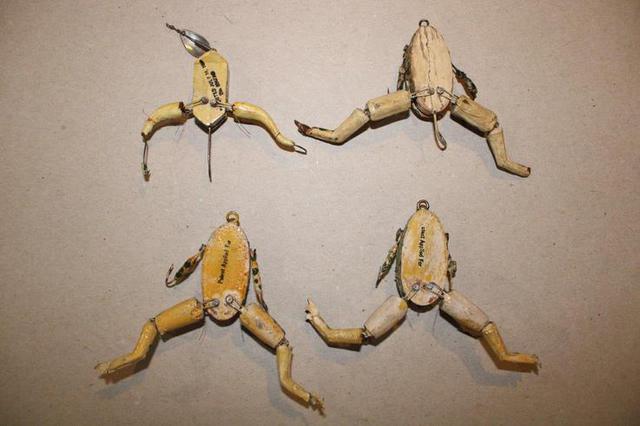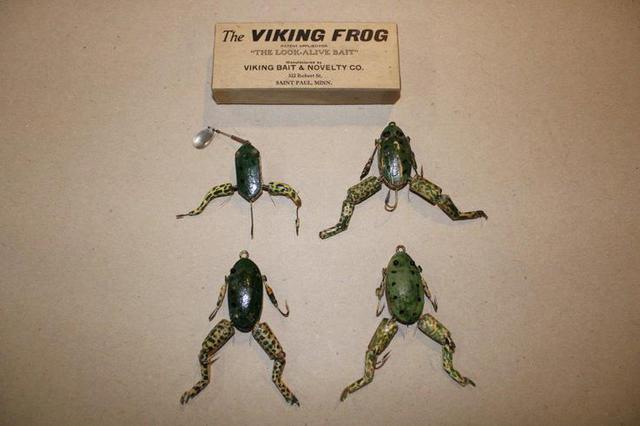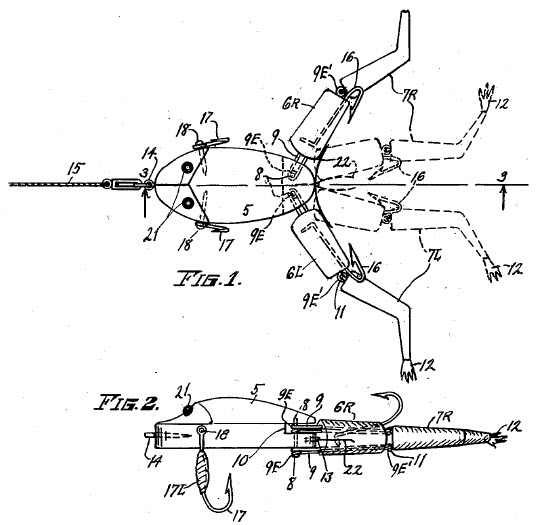When people see my lure collection for the first time, I always seem to get two questions asked.
The first question: What is your most expensive lure?
To be honest, I really can’t answer that question for I am not sure. Some lures can be worth several thousands of dollars…but to be honest…I don’t have any of these baits.
The second question: What is your favorite lure?
Most collectors would probably point at the lure that also answers the first question. Me, I would point at the lure that I feel looks the “coolest” and has an interesting history. That bait would be the Viking Frog.
In the early 1930s, Oscar Christiansen, a shoe repairman from St. Paul, Minnesota, come up with an idea for a frog fishing lure that would look and act like a real swimming frog. He carved and assembled these lures in his spare time and found that they were quite popular amongst people in Minnesota wanting to catch their next meal during the hard times due to the depression. So much, in fact, that he applied for a patent in 1935 and received one in 1936. Looking closely at his bait, you can really appreciate the ingenuity of the assembled legs and body, the hook attachments, the bead eyes, the leather feet at the end of the back legs, and the impressive hand colored and vanished frog pattern. Probably the most ingenious part of the bait is where the back legs attach to the body. It is hard to see, but there are small wires here that act like springs. When the bait is jerked in the water, the back legs move closer together and compress these “springs”. When the line is relaxed, the “springs” force the legs back out again to simulate the actual swimming motion of a live frog.
Oscar called his frog lure company the “Viking Bait and Novelty Co”. While working at a sports show several years ago, a man approached me that said he had one of the original baits made by Oscar in the box. The box had a #25 on it, and he said it was the 25th bait he sold. Now, I don’t know if this was true, but the man stated his grandpa knew Oscar Christiansen. He also told me that his grandpa said he called the frog a “Viking” because of the rumored early Viking present in Minnesota (yes, this was well before the Minnesota Vikings came to town). Also, he added the “Novelty” on the title for if it didn’t catch fish he felt that no one could complain.
The main body of the frog is wood while the front and back legs are made of “plastic wood” that is molded around the wire and hook parts of the leg. What that exactly is, I am not sure. When in the water, the weight of the legs and hardware on the bottom will cause the bait to float upright, but with a slight tilt towards the back so that the back of the lure and the legs are slightly submerged…like a real frog sitting in the water. The eyes are “bead-head tacks” that were round and black, but larger flatter tacks were also used around the time it was patented and afterwards. The frog color is green with black spots, but the shade of green can vary depending on what color he had at the time.
The original design had four hooks, two were the front legs and two were located in joints on the back legs. At the time when he decided to have the design patented, he added as option to have a three hook version that didn’t have hooks on the rear legs, but instead one larger hook at the rear of the body. Some of the lure bellies say “Patent Applied For”, while some list the patent and date, while still others are just blank.
The frogs were approximately 4 ½ inches in length. Later on, a smaller size was added that was about one inch shorter overall and the body was about half the size. This frog had three hooks…one in the body and one in each back leg. These lures did not have front legs or leather feet on the back legs like the larger version and the back legs were also not jointed. Many of these small frogs are found with some of the molded “plastic wood” missing off the back legs. The eyes on the smaller version are the larger flattened black eyes seen on the bigger frog or can be a clear or white bead that is nailed on.
Judging from the hardware and nails used to manufacturer these frogs, it is obvious to see he was also a skilled shoe repairman and used some of the same tools and skills to make these lures. There is no wonder why I like this bait so much!
The Viking Frog
The Viking Bait and Novelty Co
St. Paul, MN
Patented 1936
May 2021



